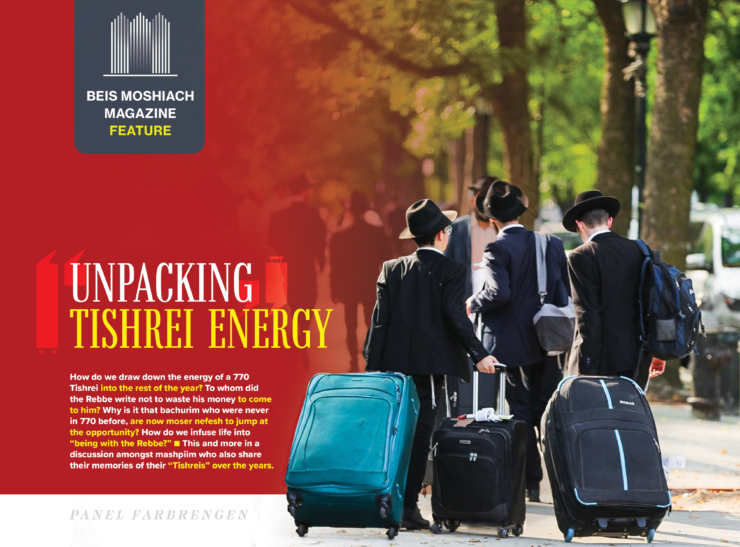Restoring the Crown to Heights
Crown Heights, Brownsville, and Canarsie – all bursting with Jewish life, all abandoned instantaneously and with devastating results. While other communities vanished from global Jewish influence, Crown Heights alone maintained and even surpassed its impact on the world at large. It remains the base of Chabad Chassidim and the home beacon for the thousands of shluchim dotting the globe. By the Beis Moshiach Magazine • Full Article
Beis Moshiach Magazine
The previous articles in this series discussed the origin of the Crown Heights community and its anticipated fall that was prevented only by the Rebbe’s timely intervention. Other neighborhoods which went through similar incidents still echo with the visions of the past and what might have been. As their communities abandoned them and left them open to the highest bidder, symbols of avoda zara were painted over the forsaken shuls and chants to foreign gods now blot out the whispers of chavrusas arguing in discarded yeshivos.
The Rebbe, standing for the holy word of halacha, fought a battle that all believed was lost before it began. The Rebbe held on to our community against all the odds. While other sects of Chassidim left with their leaders, the Rebbe stayed. We stayed.
The work of “lehachzir atara leyoshna,” restoring the crown to its greatest heights was started by the Rebbe. Its continuation is up to us.
A New Community is Born
Until about seven or eight years ago, Kingston Avenue’s domain ended at Maple Street. Past Maple was considered “forbidden territory,” an area once flooded with Yiddishkeit which now belonged to goyim. Rabbi Yitzchok Holtzman is the Rebbe’s shliach at SUNY, a college and medical center just down Kingston Avenue.
Rabbi Holtzman describes what those streets used to look like: “My family and I were the only ones here. We saw ourselves as a separate identity from Crown Heights, even though we were just further down Kingston, the main avenue of the community. We thought of ourselves as the community of East Flatbush and considered it our shlichus.“Seeing a fellow Chassid walking those streets was as shocking to us as it would be to a shliach in far-flung Asia. It was definitely not something regularly seen by me and my children.
“We worked with the students studying here. Occasionally we had a minyan when a big test was coming up, and many students stayed behind for Shabbos. However, mostly, we were the only Chabadniks to walk these streets.
“All this changed in the past three years. We built a community in this old neighborhood of Crown Heights. We took back the streets that were once ours. We came back home.
“Friday nights we have a minyan with 30+ people. From being the only ones in this area, there are now over 80 Chabad families and counting!
”One family that examined a house in this area noticed on the deed that the building had once been a shul. When they moved in, the first thing they did was set up a shul in their basement. Even our shuls are now coming back to us!
“When we first started our community, we were holding our minyanim in someone’s basement or living room. We now have a very comfortable shul and are even working on a mikvah!”Rabbi Holtzman’s gratification in seeing his hard work being so richly rewarded can be felt in his shining face and beaming smile. But it’s not only the once isolated shluchim who feel that East Flatbush is now a thriving Lubavitcher community.
The local homeowners are a family – a family of Chassidim. They all share in each other’s happiness as well as their sorrow.
“Since we moved here,” says community member Chaim Itkin, “over ten kids have been born. When one has a simcha, it is a simcha for all of us. A new baby means a new member of our growing community.
“Almost every month we celebrate a new house being bought close by. It’s an excitement and simcha for all when a new family chooses to move here. Everyone is happy. The kids have new friends to play with, and the wives are happy with the sight of new friendly neighbors.
“Since people started moving to East Flatbush, a va’ad was appointed. As of now, the main focus of this va’ad is to help yungerleit as well as established families find a suitable home for themselves in the area. A few real estate brokers from Crown Heights have moved down here themselves and began helping others find good deals on properties.”
“We are taking back our homes!” exclaimed another passionate neighbor. “Yidden in the past lived here and sold these houses for pennies, and now we are finally buying them back.” Although relative to the Crown Heights market houses in East Flatbush are cheap, they do not approach the prices for which they were originally discarded. The community is built of solid, chassidishe families: people who enjoy learning, teachers from the local schools, as well as others who work in avodas hakodesh. Most of the people who chose to move there are families with modest means. The average house costs less than half it would on the other side of Kingston Avenue. Some houses are sold for as low as five hundred thousand dollars!
Most of the houses have basements as well that can be rented out to help pay the mortgage. People who lived their whole life in a one or two-bedroom apartment are now able to live in a house which they own personally and have an option to rent. When the community first started, schools were not yet sending their buses and families were forced to carpool. Now, all schools have put these streets in their routes and children are able to get to school easily.
“We built a community!” says Menachem Lasker, another member of the community. “When I first moved down here, I was the only one on my block. People looked at me as if I were absurd, and look where we are today. We are now a growing community in Crown Heights.”
Many of the locals sing Rabbi Holtzman’s praises.
“He is the driving force and spiritual leader of the community, and we are all very thankful to him. He was here on shlichus for the school and hospital, not for Anash. He gains nothing from us. Yet he took it upon himself to arrange a shul, minyanim, and more,” Itkin enthused. “This past Rosh Hashana, 80 people davened in the minyan that Rabbi Holtzman arranged.”
When asked what message they would give their friends in Crown Heights, they answered unanimously: “Buy houses!
The Rebbe encouraged us many times to buy houses. Here is an opportunity for all. Houses are available at great prices in the middle of a very warm and loving community. All are welcome!”
What More Can be Done?
While some families were able to purchase homes and continue what the Rebbe started rebuilding, others, for various reasons, are unable to do so and wish to stay closer to the central area of Crown Heights.
Besides for grown families, Crown Heights is also blessed with hundreds of young couples who are unable to purchase a home and can only afford to rent for some time after their marriage.
These young newlywed couples have considerably increased the ranks of the Crown Heights community. Over one hundred couples marry and make their homes in Crown Heights every year.
Immediately after receiving the Rebbe’s brachah and announcing their engagement, the most pressing concern is to find a suitable living place for the first year of their marriage.
Even those looking to go on shlichus will sometimes choose to stay a year in Crown Heights to gather strength physically and spiritually before heading out on the Rebbe’s mission.
Apartment hunting in Crown Heights can be a stressful and agonizing process. While all manage to find a place to live by the time the actual wedding comes around, many need to settle for whatever they can get or afford.
It’s not lack of availability that makes the perfect apartment seem unattainable. Empty apartments abound. Their price tags, however, are often far too steep.
Even when the couple manages to find an apartment that suits them, within a few years, their family grows in size, and they need to look for a bigger place. Rental prices for a two or three bedroom seem astronomical to a young, often struggling couple.
The costs of living for a couple wishing to establish their family in Crown Heights are exorbitant. With rent at an all-time high, as well as tuition and kosher food costing more than the average, the expenses of the average frum family exceed the average income.
Williamsburg, no.
Crown Heights, yes.
The outrageous rise of prices in the Crown Heights community drove many established families as well as newlyweds to areas out of Crown Heights to neighborhoods near Monsey, Connecticut, Pennsylvania, and other newly established Chabad communities.
This migration is nothing like the mass flight of the mid-1900s in which hundreds of Yiden were chased away from Crown Heights; it’s a sign of natural growth. Still, there is place in Crown Heights near Beis Chayeinu and learning from other communities can give insight into what can be done.
Back then, the Rebbe suggested the community learn from neighboring Williamsburg and its policies.
Any contractor or developer that would like to build within the Williamsburg community must get explicit permission from the leaders of that community. Permission is only granted if the proposed building will suit the community’s needs. Frum communities can always do with more apartments with larger living areas as well as larger bedrooms which can fit two beds or more, buildings with proper staircases for Shabbos, and other conveniences for frum life.Buildings for young professionals who work in Manhattan but would rather live in Brooklyn and enjoy the easy commute to the city were not granted permission to be built within the Chassidic community.
Therefore, developers turned to Crown Heights properties for their large money-making projects.
Contractors now had free reign to build small condos perfect for young professionals (“yuppies” as they’re called) who enjoy the fast-paced business life in Manhattan, but prefer the quieter and cheaper Brooklyn for their time off. Since Crown Heights is directly connected uptown through multiple subway lines, it’s the perfect fit for them.
The issue with these apartments is that they are designed and built for singles. Single professionals with disposable income can afford to split rent with other single professionals. They don’t always need kitchens (other than a microwave) because they’re more likely to eat out. This is setting a competitive disadvantage for families, many of whom are trying to survive on single incomes. If three friends in their twenties/thirties come together with an average, monthly, take-home income of $4,000 each and they contribute ¼ of their income, they can easily afford $3K per month in rent. This adjusts the market to that price.
The prices of two or three-bedroom apartments and even one bedroom’s begin to rise. Half of the available apartments are unsuitable for family life and the ones that are have risen steeply in price. What can be done is what has been done in Williamsburg for so many years. Our community — our projects. Crown Heights first!
Instead of building projects for everyone but the members of our community, plans need to be aimed at helping our own families. The way the Rebbe solved this issue decades ago was by forming a team whose lead mission was to create proper housing for members of the community. We need a similar committee who will commit to completing buildings with larger bedrooms, large living spaces, and a proper staircase for Shabbos. The increase of such buildings will immediately lower the market prices, which will attract more and more of Anash to remain living in Crown Heights rather than running away to other communities.
The responsibility to do so rests upon the community leaders and activists, the very ones nominated by the community members to care for them. They are doing a lot in areas of security and the like, and it would be great if a team would be set up that will be in charge of such projects.
If housing becomes more affordable, everybody wins. Families have more room to save and invest in their children. Schools will be better off. Parents who have had a hard time spreading the money around will be able to pay more in tuition. Local businesses will have more customers, and more job opportunities will be created. Local shopping businesses should see growth when neighborhood shoppers have some extra cash to spend in their pockets.
Without any question, a growing community in Crown Heights benefits all in the community.Let us remember what the Rebbe did to hold on to this community. As mentioned in one of our previous articles, when the team that was purchasing buildings to create proper living space for the community ran out of funds, the Rebbe purchased shares in the company and gave dollar bills to those who bought shares as well. All so the company would have money to buy more buildings and create more projects.
The matter is so important to the Rebbe. For years and years, the Rebbe cried that action must be taken for the better of the community to return, restore, and bring back the crown of our community. Crown Heights.
***
The magazine can be obtained in stores around Crown Heights. To purchase a subscription, please go to: bmoshiach.org
135
Join ChabadInfo's News Roundup and alerts for the HOTTEST Chabad news and updates!











































